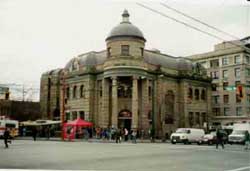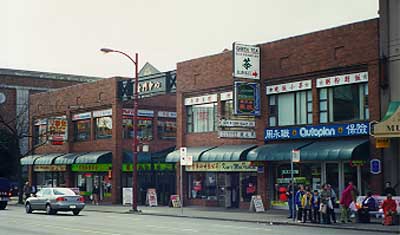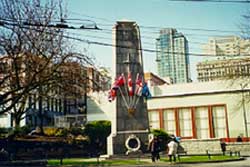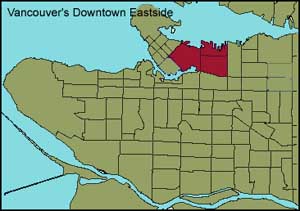|
|
-
The Downtown Eastside
As one Vancouver's most volatile and interesting neighborhood, the DTES has many forces that are simultaneously at play shaping and dictating both its present and future. These forces include the views and desires of local residents and merchants, government and public officials, and community and non-governmental organizations. The area itself is made up of seven neighborhoods:
- All of the neighborhoods are distinct so it is necessary to examine each in turn to provide more insight into the issues at play in each sub-area.

|
Chinatown:
Vancouver's Chinatown is one of the last remaining large Chinatowns in North America. It is facing increased pressure as Asian theme malls in suburban areas are reducing its previous role as a central shopping district for the Chinese community in the lower mainland. At the same time, merchants are blaming restrictive government zoning and development policies, insufficient parking and increased crime as other reasons why the neighborhood's vitality is decreasing. Chinatown will have to struggle if it is to retain its character and soul.
|
Gastown:
Gastown, along with Chinatown, is a provincially designated heritage area as well as an important tourist destination. It has seen a rapid rise in housing prices as the area has become more attractive to middle-income individuals drawn to the area by its many amenities and cultural opportunities. The city has put an emphasis on preserving its heritage, which has resulted in many restrictions on the ways in which property owners can modify their buildings. To compensate for this, the city allows many different types of land uses, which has resulted in a varied land use mix in the neighborhood.
Merchant in the are would like to see heritage preserved and the land use mix increased. This has been interpretted as a driving force behind low-income displacement in the area, resulting from escalating property values (and therefore rent).
|

|

|
Downtown Eastside Oppenheimer District (DEOD):
This area contains the poorest postal code in Canada (McCullough 1994). It is portrayed as a home to rampant drug use and crime. It is home to a growing number of social services, which include rehabilitation centres, a needle exchange program, homeless shelters as well as community groups catering to the needs of the homeless.
One of the city's stated objectives for the area is to maintain its social housing. To this aim, a number of restriction have been placed on development in the area, which has resulted in very little new private development. The majority of new residential development has therefore been publicly funded social housing.
|
Thornton Park (Railway):
This area marks the southern boundary of the DTES, and is closely related to Chinatown. The arrival of Citygatein the early 90's aroused fears of gentrifiaction in the area at that time.
A study done on this area by the planning department showed that it would be a good area for a mixture of residential and commercial activities, with an emphasis on modest and lower-income housing. It will likely grow into a modest-income neighbourhood with a variety of housing including condominiums, single room occupancies hotels (SRO's) and social housing.
|

|

|
Strathcona:
This neighbourhood is bounded by Oppenheimer, Chinatown and Hastings North. It is evolving into a desirable mixed-income community based on special heritage and ethnic characteristics. The development has focused on preserving the heritage fabric of the neighbourhood as well as increasing the amount of park space and other urban amenities. In the future, housing development will focus on smaller-scale renovations with the possibility of social housing being built.
|
Victory Square:
This area is seen as the most contentious in the DTES in terms of future development. This is the result of a desire to balance the needs of the low-income individuals in the neighbourhood with those of merchants community. This city is attempting to reach this goal through proposed zoning that seeks to blend affordable housing with heritage interests and the land use needs of the merchant community. Surely, this neighbourhood will be the scene of future conflicts amongst the various parties who have an interest in its re-development.
|

|
Hastings North (Industrial):
This area is dominated by industrial interests with the exception of two previously approved residential / commercial projects.
|
As it can be seen, the DTES is in store for great strife and conflict as the various actors strive to have their voices heard in deciding the fate of Vancouver's "Mythical Wasteland."
|
|






